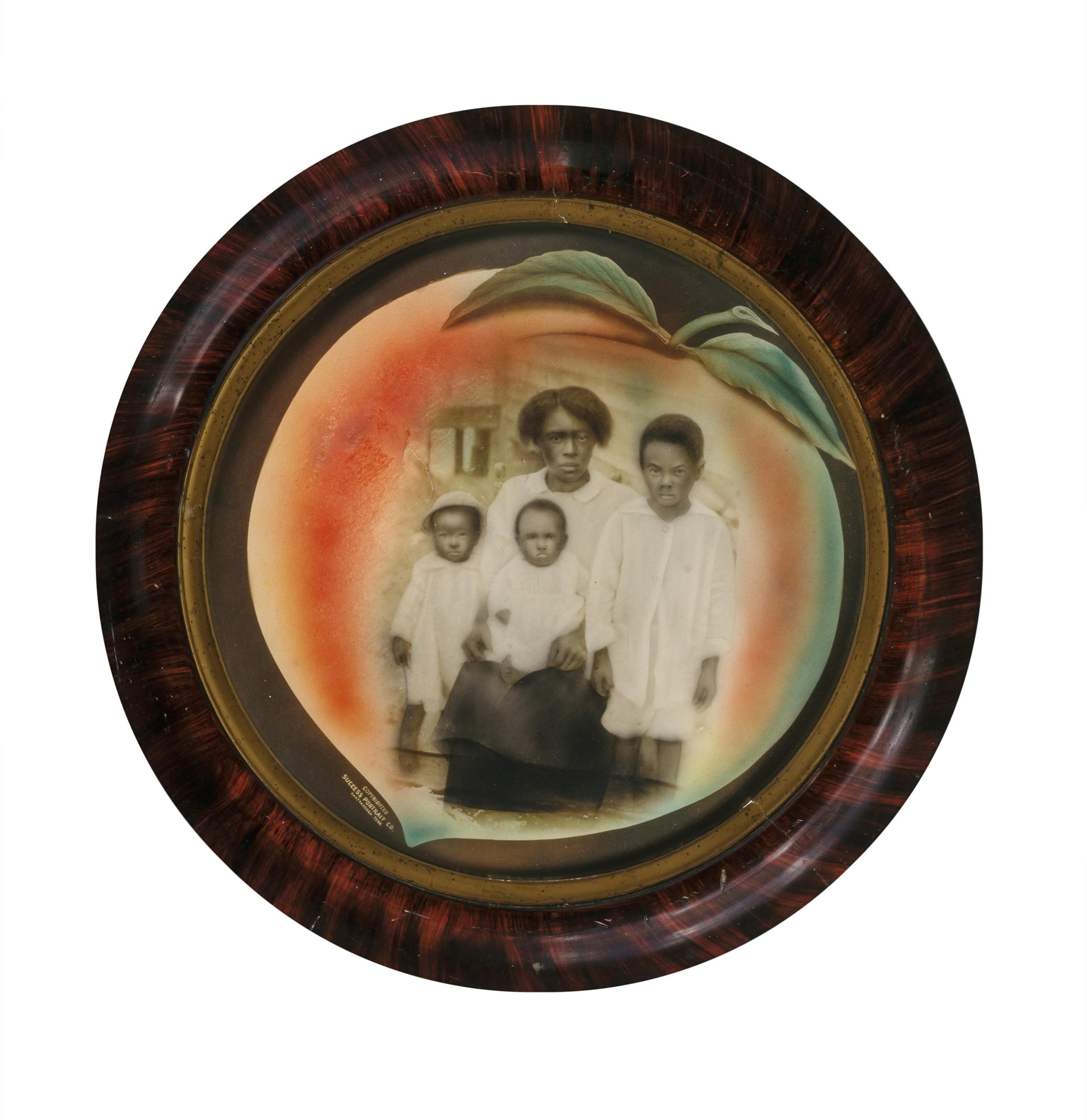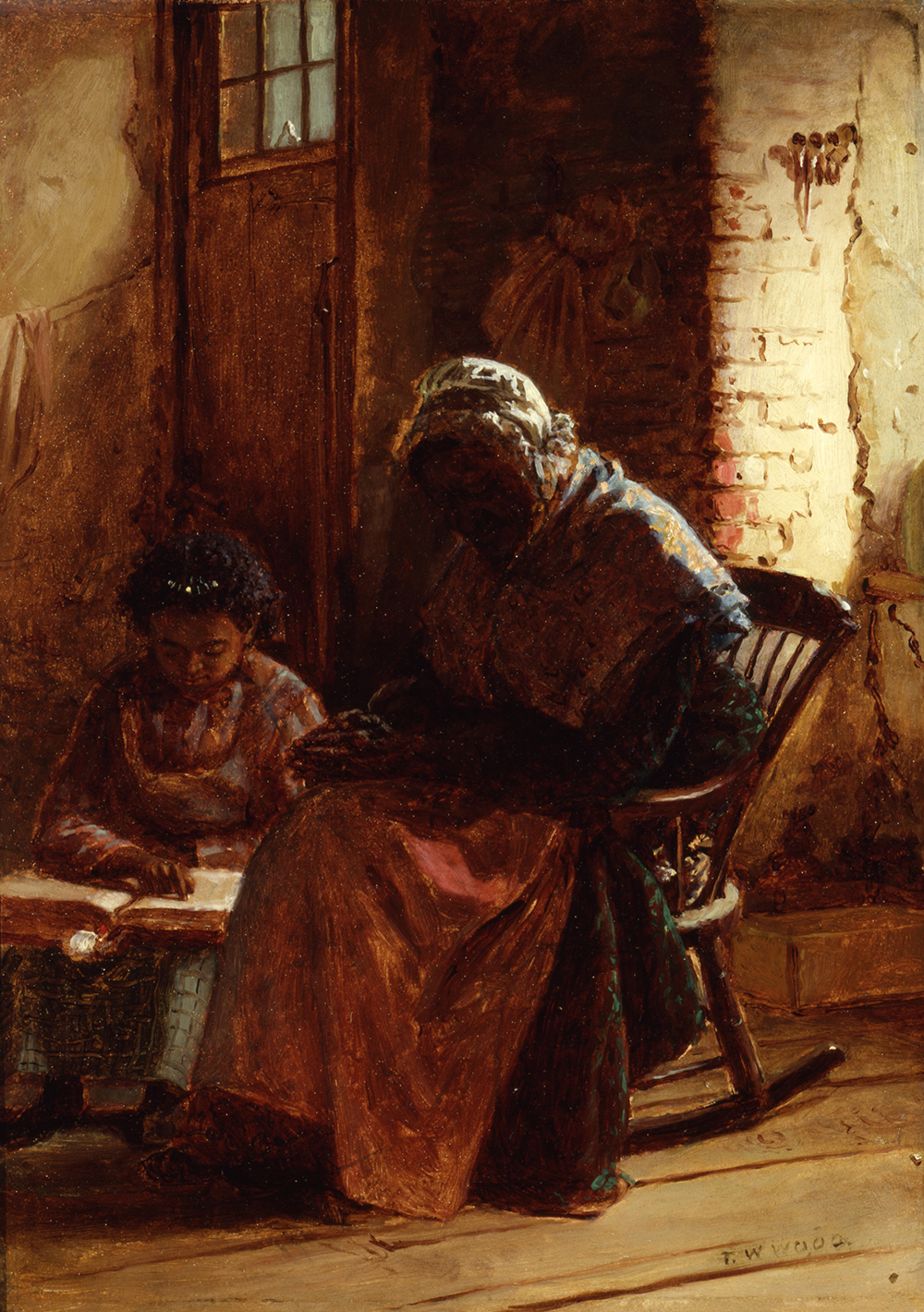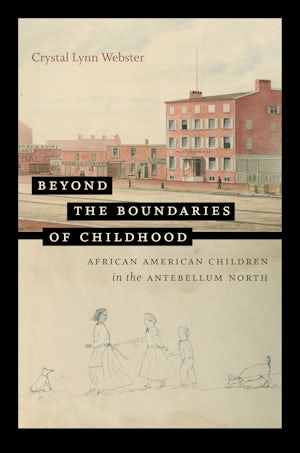
African American mother and children in peach vignette, c. 1885. Smithsonian American Art Museum.
As Black parents attempted to reunify their families in the wake of gradual emancipation, institutionalization, and indenture in the early nineteenth century, the discourse on Black child-rearing evolved to reflect their daily activism. The treatment of African American children and the activism of their parents were often led by Black women, who renegotiated racialized constructions of motherhood depicting “deviant,” powerless Black mothers. In their actions and discourse, northern African American women represented Black motherhood in ways that led to the development of radical forms of abolitionist activism and early Black feminism. Within their gendered constraints, northern African American women challenged the very constructions of motherhood by assigning political authority to their embodiments of maternal care.
In 1826 whites denied Sojourner Truth, born Isabella Baumfree, possession of her child. Although decades had passed since gradual emancipation was enacted in New York, Truth’s son Peter remained enslaved and was sold out of state, violating the law forbidding the sale of enslaved persons across the border into a slaveholding state. Despite being self-emancipated, Truth was unable to bring her own children out of bondage, and she was faced with the inevitable separation of her son once he was sold to Alabama. Although Truth took legal action and successfully appealed the illegal sale, which resulted in the safe return of Peter a year later, the experience led to the irrevocable loss of his innocence and altered the intimate bonds between the mother and her child. The trauma of southern slavery had left an indelible mark on Peter’s childhood, and on Truth’s motherhood.
Sojourner Truth used mourning as a way to convey both the disruption of family and the loss of motherhood rights in relation to the separation from her children. In her narrative, Truth recalled the sale of her brother and the emotional response it elicited from her parents. The memory of observing her parents as they faced being separated from her brother provides a compelling depiction of mourning practices in the North for children who were not yet dead but who had been permanently removed from their families. Truth described how her parents, whom she portrays as having a “natural affection for their offspring,” reconstructed the event for her for hours, “recalling and recounting every endearing as well as harrowing circumstance that taxed memory could supply, from the histories of those dear departed ones, of whom they had been robbed and for whom their hearts still bled.” The loss of Truth’s enslaved brother, though he was still alive, represented the loss of a family and community member who possessed emotional capital.
In Truth’s own experience with being forcibly separated from her child Peter, she converted the mourning meditations and practices of her mother into active resistance. Truth did not have legal guardianship over her son when the enslaver Solomon Gedney purchased him. However, Truth had self-assigned maternal authority and was determined to enact Peter’s safe return. She began by traveling to New Paltz, New York, and confronting her former mistress, Sally Dumont. Through the aid of Quaker abolitionists, as well as lawyers John H. Rutzer and A. Bruyn Hasbrouck, Truth was advised to appear before a grand jury in Ulster County. After swearing before the jury that her child had been taken, she was supplied with a writ to deliver to Solomon Gedney. Truth walked “eight or nine miles” to do so. Meanwhile, Gedney was told by his own lawyer to return the boy or else he might be forced to pay $1,000 and serve fourteen years in prison. So, months later, Gedney returned with Peter. When Peter was reunited with his mother, however, it was not as a free child, as he was still enslaved. Meanwhile, through the public legal action taken to retrieve her son, Truth was introduced to the contentious public debate over slavery and emancipation, an experience that exposed her to antislavery networks and initiated her entrance into political activism.
Despite Truth’s efforts, according to her narrative, Peter responded to his mother with distress and consternation when he returned, an emotional response that is not unsurprising for a child who had recently endured a physically and psychologically traumatic experience. Peter “denied” his mother and entreated to be returned to his master, who had “brought him from the dreadful South.” After some coaxing from Truth, he finally admitted, “Well, you do look like my mother used to.” This was undoubtedly an agonizing reunion for Truth after her laborious and expensive efforts to retrieve Peter. Her published work countered assumptions of Black mothers’ perceived lack of control over the fate of their children and transformed affective mourning to active determination. This shifting expression of motherhood represented changing notions of Black women’s autonomy over their children, which emerged as a response to the conditions of enslavement and newly acquired freedom.
The public declarations of African American women and their children contributed to an antebellum discourse on enslaved motherhood within abolitionist literature and free Black women’s writings and activism. From its inception as a forum for Black abolitionists, the Christian Recorder sought to empower African American women as embodiments of a Christian, moral motherhood in the upbringing of their children. The Christian Recorder was the official newspaper of the African Methodist Episcopal Church in Philadelphia and was influenced by religious rhetoric that merged Christianity with the Black experience. The newspaper was written primarily for an African American readership, and its discourse on Black motherhood reflected the aims of its northern, free African American audience.
In the Christian Recorder and other African American newspapers, Black women were advised to perform duties of true womanhood, wherein they were responsible for household chores, the education of their children, and maintaining high moral standing as part of a racial uplift ideology. These expectations were in conflict with the living conditions of the North, however, where Black women frequently worked as servants, were perceived as sexually promiscuous, and had limited resources for their children. Free Black women did not have the same access to “respectable” motherhood as white women. They therefore imagined a space to embody ideas of powerful, autonomous mothers. The pages of the Christian Recorder became a site to produce and circulate constructions of Black motherhood that in one sense reinforced gendered notions of domesticity, and in another reaffirmed forms of Black women’s—and by association, children’s—subjectivity.
Throughout the publication of the Christian Recorder, articles with titles such as “Advice to Mothers,” “A Mother’s Love,” and “My Mother Knows Best” centralized the role of Black motherhood. These articles characterized Black mothers as powerful actors with the ability to instill not only religious morals but also social lessons that resonated with the northern free Black readership.

Published on the eve of the Civil War in February 1861, “To Mothers,” authored anonymously, represented the significance of Black motherhood in the North. The didactic piece featured twenty steps African American women ought to enact in order to embody proper motherhood. Many of these steps reflected the northern Black community’s ideas about religion, education, motherhood, and childhood. The article begins with commentary on women’s role in children’s education, stating, “The first book read and the last book laid aside by every child is the conduct of its mother.”
The focus on Black women’s roles in the education of their children was primarily a northern middle-class phenomenon due to the restrictions placed on literacy under slavery as well as the antiliteracy laws of the South. In the North, African American women played an influential role as teachers of young, malleable minds. Indeed, the third recommendation in the article “To Mothers” further emphasizes the values of education and motherhood by encouraging women to “let your whole course be to raise your child to a high standard.” This recommendation was in line with sentimental notions of motherhood. While the proper upbringing of children had previously been assigned to males, as white middle-class values confined women’s work to the home, the focus of women’s labor evolved to encompass the educational, in additional to the emotional, care of their children. Therefore, the previous economic attachment connected to children’s labor evolved into an emotional protection of childhood as a developmental phase free from work. As Black women gained access to the public sphere through Black abolitionism and print culture, they attempted to align themselves to these ideas of proper womanhood. Yet teaching their children at home would have been difficult for most northern African American women, as their labor was never solely confined to the realm of the domestic sphere under slavery or within the economic conditions of the North.
The article did, however, introduce ways in which northern Black mothers might conceive of teaching as a private action and a public career. While the majority of Black women and children did not have access to schooling, some northern Black women entered careers in teaching as part of activism concerned with Black children. These women were sometimes educated in families that had access to opportunities allowing them to privilege education over labor outside of their homes. The Forten sisters, Sarah (Mapps) and Grace Douglass, Susan Paul, and other Black women were active in abolitionist circles. Sarah Mapps Douglass opened a school for African American girls and led the girls’ department of the Philadelphia Institute for Colored Youth. Black women also used the Black church as a means to exhibit maternal capacities to the wider northern Black community. In their informal leadership and involvement in the church, middle-class African American women, as mothers and as women, saw it as “their duty to raise children but also to lead an infant free Black community to a mature educated adulthood,” as historian Erica Armstrong Dunbar has demonstrated. They believed in doing this work in ways that “blurred the distinction between the public sphere and the private.”
The Christian Recorder’s role in the construction of a discourse on northern Black motherhood was not confined to literary commentary. The newspaper also advertised events designed specifically for Black mothers. The December 6, 1862, issue encouraged free Black women to attend a lecture on motherhood given by Reverend Elisha Weaver, the newspaper’s editor, at Brick Wesley Church. The event proposed to “wake up mothers to their duty.” Women were charged fifteen cents, half of which went to the Christian Recorder. The event was expected to elicit high attendance, as the organizers hoped to sell five hundred tickets. Such lectures were intended to instill in African American women particular values of motherhood embedded within notions of respectability. These values were undoubtedly gendered and commonly included critical commentary about women who did not express womanhood along axes of education, domesticity, and submissiveness. In doing so, the Black press constructed Black mothers in ways that countered the subjugation of Black children. African American women influenced and adopted such articulations of motherhood in their own contributions to the newspaper.
The Christian Recorder also provided northern Black women with a way in which to participate in the public political landscape. African American women, including Sallie Duffin, Lizzie Hart, Frances Ellen Watkins Harper, and many others, contributed poems, short stories, and political commentary to the newspaper. However, women whose personal narratives cannot easily be traced within the historical archive also influenced the discourse on motherhood visible in the Christian Recorder and other Black periodicals. “Home-Training” (April 12, 1862), authored by “Minnie,” provided a religious characterization of the duties of fathers and mothers in the proper care of their children. Minnie warns parent readers of the newspaper against sending their children to Sabbath school without supplementing their educational and religious instruction at home. Sabbath schools were a valuable means of educating African American children in the antebellum North in the midst of racial segregation and discriminatory practices that limited Black children’s access to quality educational spaces—so Minnie’s missive served as an important reminder.
Issues of the Christian Recorder published during the Civil War were distributed throughout the South by Union Army soldiers. Articles concerned with the influential role of mothers in education may not have resonated as strongly in the South as they did in the North, however, as the southern context not only included the frequent sale of enslaved children but also infant mortality rates double those of white children. Yet “A Mother’s Influence,” authored by “U. Pres” and published on December 17, 1864, depicted the authority of maternal bonds that were initiated by the birth of a child, beginning with the “first and faintest dawn of intellectual consciousness”—an image sure to resonate with southern mothers as well as northern. According to the article, all mothers possess “a powerful influence [that] is already passing from the face and voice of the mother to the heart of the child.” The article directly addresses motherhood under slavery, claiming that despite the separation of an enslaved mother from her child, the “heart of the child was still in the home of his mother.”
Excerpt from Beyond the Boundaries of Childhood: African American Children in the Antebellum North by Crystal Lynn Webster. Copyright © 2021 by the University of North Carolina Press. Used by permission of the publisher.
